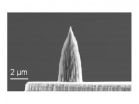(Press-News.org) Scientists are reporting a simple way to improve the sensitivity of the test often used to detect traces of explosives on the hands, carry-ons and other possessions of passengers at airport security screening stations. Their report appears in ACS' The Journal of Physical Chemistry C.
Yehuda Zeiri and colleagues explain that most tests for traces of explosives begin by rubbing a swab made from glass fiber, Teflon or cotton over the suspect material. Analysis of the swab in a detector — usually a device called an ion mobility spectrometer — alerts agents to any explosive residues on the swab material. Common explosives like TNT are solids with very low vapor pressure at room temperature, so the best way to detect them is to search for particulate traces that rub off on clothing and luggage. To help security agencies prevent attacks more successfully, the researchers studied how explosive particles adhere to surfaces and how they could improve swabs to pick up even smaller amounts of explosives.
Using an atomic force microscope to measure the adhesive forces between explosive particles and different self-assembled monolayers, the scientists concluded that swab fabrics could be improved to collect smaller amounts of explosives by peppering them with hydroxyl, phenyl and amine functional groups. They believe that such additions could enhance the binding between the swab and irregularly shaped explosive particles.
###
The authors acknowledge funding from the U.S. Department of Homeland Security.
The American Chemical Society is a nonprofit organization chartered by the U.S. Congress. With more than 164,000 members, ACS is the world's largest scientific society and a global leader in providing access to chemistry-related research through its multiple databases, peer-reviewed journals and scientific conferences. Its main offices are in Washington, D.C., and Columbus, Ohio.
To automatically receive news releases from the American Chemical Society, contact newsroom@acs.org.
Boosting the sensitivity of airport security screening
2012-11-14
ELSE PRESS RELEASES FROM THIS DATE:
Ingredient in diarrhea medicine leads to sustainable new farm fertilizer
2012-11-14
The search for a sustainable slow-release fertilizer — a key to sustaining global food production at a time of burgeoning population growth — has led scientists to an ingredient used in some diarrhea medicines. They describe use of the substance, attapulgite, as a "carrier" for plant nutrients in a report in ACS' journal Industrial & Engineering Chemistry Research.
Boli Ni and colleagues explain that about half of the 150 million tons of fertilizer used worldwide every year goes to waste. That's because most fertilizers release nutrients too fast for the crops to use. ...
Nanometer-scale diamond tips improve nano-manufacturing
2012-11-14
One of the most promising innovations of nanotechnology has been the ability to perform rapid nanofabrication using nanometer-scale tips. The fabrication speed can be dramatically increased by using heat. High speed and high temperature have been known to degrade the tip… until now.
"Thermal processing is widely used in manufacturing," according to William King, the College of Engineering Bliss Professor at the University of Illinois at Urbana-Champaign. "We have been working to shrink thermal processing to the nanometer scale, where we can use a nanometer-scale heat ...
Life and death in a star-forming cloud
2012-11-14
The aftershock of a stellar explosion rippling through space is captured in this new view of supernova remnant W44, which combines far-infrared and X-ray data from ESA's Herschel and XMM-Newton space observatories.
W44, located around 10 000 light-years away within a forest of dense star-forming clouds in the constellation of Aquila, the Eagle, is one of the best examples of a supernova remnant interacting with its parent molecular cloud.
The product of a massive star that has already reached the end of its life and expelled its outer layers in a dramatic explosion, ...
You can be a star -- on science's stage
2012-11-14
The rapid growth in "citizen science" projects during the past decade is enabling more and more science enthusiasts, hobbyists, students and other ordinary people to participate in the excitement of real-world scientific research and help solve serious scientific mysteries. That's the topic of the cover story in Chemical & Engineering News (C&EN), the weekly newsmagazine of the American Chemical Society, the world's largest scientific society.
Deirdre Lockwood, C&EN contributing editor, traces the growth of citizen science from the Audubon Christmas Bird Count of 1900 ...
Television: Chronicle of a death foretold?
2012-11-14
Not only is TV not endangered, but it also has a unifying social impact on the nuclear family across the country. This is the main conclusion of a cross-Canada study—Are the Kids All Right?—on the television viewing habits of families with at least one child aged between 9 and 12 years. The study was conducted by a team of researchers led by André H. Caron, professor of communications at Université de Montréal and Director of the Centre for Youth and Media Studies (CYMS).
"Young Canadians today live in a different world than that experienced by previous generations. In ...
Could poor sleep contribute to symptoms of schizophrenia?
2012-11-14
Neuroscientists studying the link between poor sleep and schizophrenia have found that irregular sleep patterns and desynchronised brain activity during sleep could trigger some of the disease's symptoms. The findings, published in the journal Neuron, suggest that these prolonged disturbances might be a cause and not just a consequence of the disorder's debilitating effects.
The possible link between poor sleep and schizophrenia prompted the research team, led by scientists from the University of Bristol, the Lilly Centre for Cognitive Neuroscience and funded by the ...
World's largest respiratory genetics study launches on World COPD Day
2012-11-14
Researchers from the Universities of Nottingham and Leicester are leading the largest ever study of the genetics relating to lung disease.
The project will investigate what determines an individual's lung health and why smoking harms the lungs of some people more than others and will use health information held by UK Biobank, a major national resource holding health information from half a million volunteers.
The study, funded by the Medical Research Council (MRC) and also involving scientists at St George's, University of London, is aiming to shed light on why some ...
How safe are our roads for Bradley and the nation's cyclists?
2012-11-14
A new government-funded study is to be carried out into how Britain's roads could be made safer for cyclists to reduce the risk of cycling injuries, encourage more people to use bikes and improve public health.
Amid fresh calls for action on road safety after the recent separate accidents involving world-famous cyclist Bradley Wiggins and the top cycling mentor Shane Sutton, researchers at The University of Nottingham are leading a study which will assess the effectiveness of the current cycling infrastructure and ask 'which features installed for cyclists are most effective ...
What lies beneath? New survey technique offers detailed picture of our changing landscape
2012-11-14
A new surveying technique developed at The University of Nottingham is giving geologists their first detailed picture of how ground movement associated with historical mining is changing the face of our landscape.
The new development by engineers at the University has revealed a more complete map of subsidence and uplift caused by the settlement of old mines in the East Midlands and other areas of the country and has shown that small movements in the landscape are bound by natural fault lines and mining blocks.
It appears to support concerns that movement associated ...
Lmod: The 'secret sauce' behind module management at TACC
2012-11-14
It's likely that fellow users on your favorite supercomputer have widely varying needs. The applications, compilers, and libraries that you need are probably different from the ones other users need. That is where modern environment module systems come in. A good module system "sets the table " for users by loading the packages each user needs.
The Texas Advanced Computing Center (TACC) has developed an innovative module system that addresses some unique challenges facing modern computing centers.
Life in the world of computing has become much more complicated since ...


